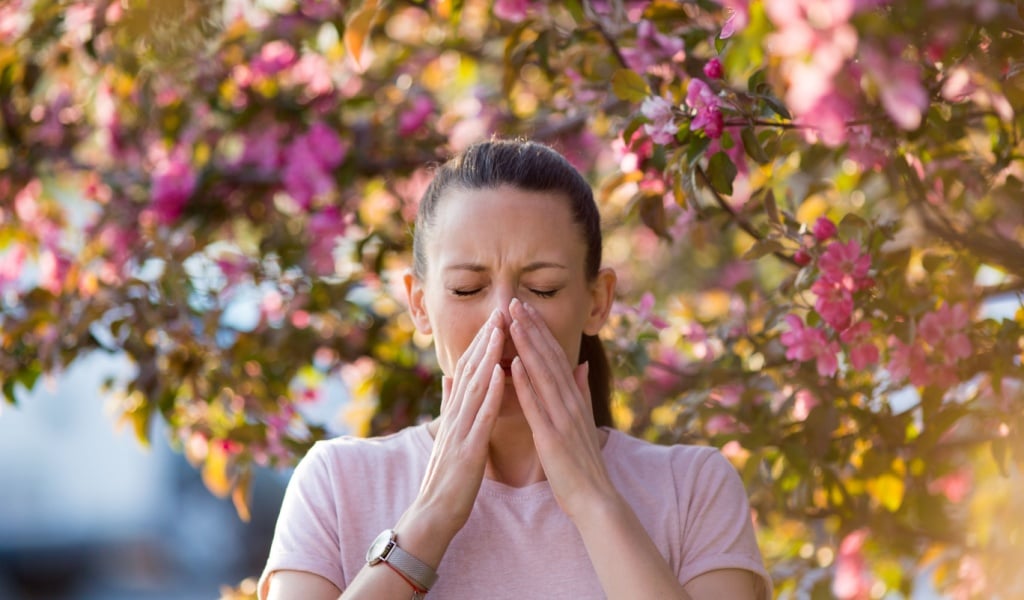As seasons change, our bodies may take some time to adjust to external environmental changes, leading to seasonal allergies. Spring is particularly notorious for triggering allergies; as winds, flowers bloom, and the winds pick up, allergens move through the air more easily, increasing the likelihood of adverse reactions.
Although you may outgrow these allergies over time, there may be an adjustment period during which your body reacts adversely to the new allergens. Symptoms of these allergies include coughing, sneezing, itchiness, redness of the eyes, and rashes, among others. But is there a way to avoid suffering through them? Let’s explore.

Spring Allergy Season
Many types of vegetation use pollen for fertilization. Spring is the season when flowers bloom and pollination is at its peak. A rise in pollen count can also increase the likelihood of allergic reactions.
Pollination occurs in various ways, but the type that can cause an allergic reaction is wind pollination. Strong winds easily blow away light pollen grains. Trees and grasses like mulberry, bermuda, rye, and pine are common pollen sources. When these pollen grains drift through the air, they come into contact with humans, often triggering symptoms such as sniffling and sneezing, which are classic signs of allergies.
Spring typically begins in late February or early March and can last until early summer. However, the timeline varies and depends on your region’s climate. In some areas where pollen persists for an extended period, allergies may continue for a prolonged time. If you are sensitive to seasonal changes, it is essential to understand your country’s climate and how long pollen tends to remain in the air. This way, you can enjoy the season without needing to stay huddled at home!
Common Causes of Spring Allergies
Different allergens cause problems for different people. The most common causes of spring allergies include tree and grass pollen, mold spores, insect bites, and even indoor pollutants. Let’s have a quick look at each of these allergy triggers:
Insect Bites And Stings
Insect bites and stings could cause pain, be itchy, or swell where you got bitten. In some cases, these could cause severe allergic reactions like anaphylaxis. It is essential to look for symptoms such as swelling in the lips or throat, or if someone has trouble breathing after a bite or sting, they should seek medical help immediately.
Molds Spores
Mold can cause allergy symptoms in spring. It spreads by releasing tiny seeds called spores, which float in the air. Mold can spread more readily when the weather is dry and windy, or when it’s humid due to dew or fog. Outdoor mold can grow on rotting wood, dead leaves, and other damp spots. Indoors, mold often appears in bathrooms, kitchens, and basements with poor ventilation.
Tree and Grass Pollen
Many plants use pollen to reproduce—insects spread around the large, sticky pollen found on bright flowers. However, those that are light in weight, dry, and small are easily carried by the wind; often, these are responsible for triggering allergies. Trees are one of the primary culprits of spring allergies in the US., though weeds and grasses could also contribute significantly.
Dust Mites
These tiny creatures are major asthma triggers. They are usually found in warm and humid environments, such as furniture, carpets, and bedding, and are not visible to the naked eye – you will need a powerful microscope to see them! The most typical symptoms caused by dust mites include sneezing and a runny nose.
Pet Dander
The popular belief is that pet allergies are caused by the pet’s fur or feathers; however, with the advancement of allergy research, this has been proven to be incorrect. Experts have determined that it’s the protein present in an animal’s glands that triggers allergy in humans, rather than fur. These proteins are tiny and, surprisingly, can cause severe allergic reactions throughout the year.
Airborne Irritants
Although this isn’t just a spring allergy, it is vital to know that chemicals from cleaning products and smoke from cooking are all indoor air pollutants that can be more serious and cause a higher risk of allergy compared to outdoor pollution. This is because these pollutants appear to circulate within the household, making them a greater risk. They could lead to headaches and runny noses. These airborne irritants require special attention, regardless of the season, whether it is spring, summer, or winter.

What Are The Symptoms Of Seasonal Allergies?
Sneezing and coughing may seem like milder allergies, but if left untreated, they could worsen and lead to chronic conditions later. Therefore, it is crucial to recognize these symptoms and manage and treat them as soon as possible.
Sneezing and runny nose: These could be common reactions caused by dust mites and pollen. These symptoms are hard to ignore, especially when sneezing becomes a constant.
Coughing and wheezing: Due to a reaction to allergens, the airways can get irritated, making it difficult to breathe. When you experience difficulty breathing, it’s a clear sign that you are having a wheeze, and you should seek medical attention immediately.
Skin rashes: Your skin may break out in a rash, becoming slightly bumpy and red. These rashes can also be itchy.
Red and itchy eyes: Irritation and redness of the eyes are often a response to pollen and air pollution.
Pain in the sinuses: Prolonged exposure to allergens may lead to discomfort or pressure in the sinus area.
When Should You Consult The Doctor?
When allergic symptoms persist, and you constantly suffer from a blocked nose or breathing complications, it’s best to consult the doctor immediately. If you are aware of the common allergies that occur during the season, taking prior precautions can help you avoid severe reactions.
Furthermore, as normal as it may seem, persistent itchy eyes or breathing difficulties can significantly reduce the quality of your life and interfere with daily activities. In such cases, seeking immediate medical attention is essential!
Conclusion
Seasonal allergies are common and can cause discomfort due to symptoms such as constant sneezing, coughing, itching, and more. However, they can be managed or prevented with proper precaution and good medical care, allowing you to enjoy the season more comfortably each year. So don’t be afraid to enjoy the weather and smell the flowers, literally!



